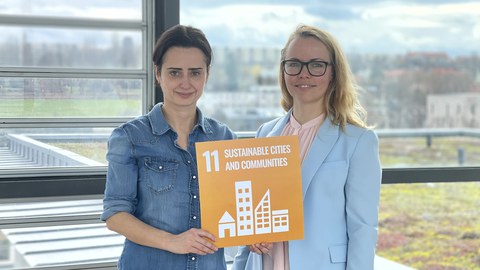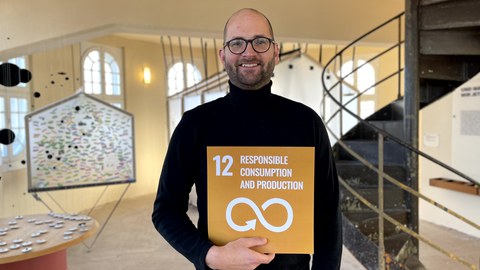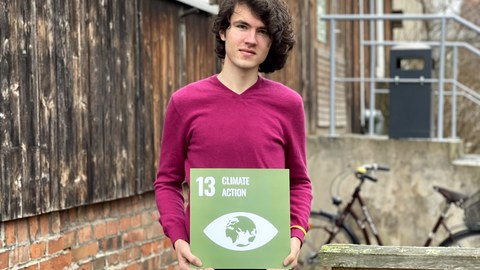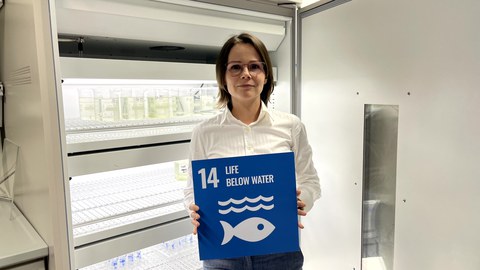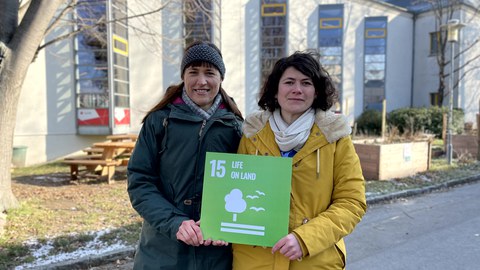planet
SDG 11 "Sustainable Cities and Communities" - NeutralPath & Climate-neutral Cities
Regine Kramer from the City of Dresden and Dr. Peggy Freudenberg from the Institute of Building Climatology at TU Dresden are both supporters of SDG 11:
What is the project about and how does it relate to SDG 11?
Alongside more than 370 European cities, the city of Dresden entered a European application process at the end of 2021/beginning of 2022, thereby expressing its interest in becoming part of the EU mission “100 climate neutral and intelligent cities by 2030.”
This EU mission is one of the five EU missions in the European research and innovation framework program entitled Horizon Europe (funding period 2021-2027). The five research and innovation missions are dedicated to addressing and solving the major societal challenges of our time in a visible and measurable way, as well as within a defined time frame.
At the end of April 2022, participation in the EU mission was officially confirmed. Aachen, Dortmund, Dresden, Frankfurt/Main, Heidelberg, Leipzig, Mannheim, Munich and Münster were selected from Germany. These cities will act as experimentation and innovation centers to test and demonstrate ways to achieve climate neutrality.
75% of EU citizens live in urban areas. Overall, urban areas consume more than 65 percent of the world’s energy and are responsible for more than 70% of CO2 emissions. It is therefore important that these cities act as experimental and innovation ecosystems, helping others to transition to climate neutrality by 2050.
Many coordinated measures should work together to ensure future climate neutrality. Among other things, the intense energy demand of Dresden’s high performance industry is to be reliably covered by renewable energies. Energy is being increasingly harnessed in the surrounding region using photovoltaic (PV) systems, in addition to wind energy. The district heating system is being readied for the future integration of renewable energies. The increased use of renewable energy also requires a means to store the electricity and heat in order to better balance production and demand.
Transportation and mobility are also key issues. When it comes to waste and refuse, it’s all about Smart Waste: Digitalizing management for the collection of waste and recyclable materials: Linking databases, using tracking and telematics systems to optimize the planning of collection routes for 135,000 containers - ranging from use and maintenance to replacement and recycling. Closing energy and material cycles and developing smart city applications are also envisaged, as are innovative mobility concepts and clear sustainability specifications for the construction and refurbishment of municipal buildings.
Successfully implementing the energy transition with climate-neutral buildings and cities is a major challenge that we have to face. The city of Dresden and the Institute of Building Climatology are working with other partners in the Neutral Path project to find solutions.
We, at the Institute of Building Climatology, strive to develop climate neutral engineering solutions in the building sector for building and systems. Both aspects, building and systems engineering, must be considered holistically for regenerative supply concepts to function sustainably and economically.
On the building side, the biggest challenge is to upgrade existing buildings. The current rate of refurbishment is too low and the measures implemented are often insufficient. However, much can still be achieved even in light of strict historic preservation requirements, for example with suitable interior insulation systems. In the area of systems engineering, we want to demonstrate viable alternatives to traditional combustion technologies. For light building structures, these could be self-sufficient regenerative supply systems, for example in the form of a predominantly PV-powered heat pump that uses geothermal heat on site to heat buildings. For dense structures, similar technologies are suitable if implemented in bundles, i.e. in heat grids. To this end, we need innovative planning tools and marketing models in addition to the technologies themselves. We are currently testing this as part of the EU project Neutral Path for Pillnitz and Leuben, two neighborhoods in Dresden, in cooperation with the city of Dresden, the energy supplier, the housing associations and other stakeholders. These model projects are being developed with our own software SIMBICUS, which is unique in that it combines building, soil and device simulation.
Further information on our software: https://www.sim-vicus.de/en/
Further information about the institute: https://tu-dresden.de/bu/architektur/ibk
Further information about the project: https://tu-dresden.de/bu/architektur/ibk/forschung/projekte/forschungsprojekte-2023/Neutralpath
SDG 12 "Responsible Consumption and Production" - Exhibition "Wolke 8 - das Klima und Wir"
Holger Seifert is the project leader for the exhibition Ausstellung "Wolke 8" at the Technical Collections Dresden and a supporter of SDG 12:
What is the project about and how does it relate to SDG 12?
Technical Collections Dresden is the museum for science and technology of the city of Dresden.
The project “Wolke8" The Climate and Us” is a cooperative endeavor involving researchers from TUD. It is a new, permanent exhibition on the topic of climate change and addresses the questions: What is climate? What is climate change? What does it to do with me? How do you explain it with physics? Where does our knowledge about it come from? What can I do?
In this project, we refer primarily to SDG subgoal 12.7: the promotion of sustainable practices in public procurement. While setting up the exhibition, we made sure to act sustainably at each level - e.g. upcycling of discarded desks from the city of Dresden to put on display or seats made from the leftovers of felt production. We therefore act as a role model for sustainable exhibition production in the (publicly financed) cultural sector.
What word would you use to describe this project that focuses on SDG 12?
Just do it!
SGD 13 "Climate Action" - change TUD
Moritz Schulz is a member of the group changetud and the TU Environmental Initiative (TUUWI), and also a proponent of SDG 13:
What is the project about and how does it relate to SDG 13?
The students are committed in many ways to sustainable action and the protection of the foundations of life in order to create a livable existence for all: both today and in the future. To this end, we are making TU Dresden and its environment more sustainable by actively initiating and realizing projects. We contribute to educating and spreading awareness in the context of education for sustainable development, and we actively participate in decision-making committees at the university. With this in mind, we anchor both adaptation to climate change and ecological course-setting into strategies and planning. Furthermore, we mobilize actors who can assist us in protecting the environment. To achieve this, we do our best to ensure reasonable financial support of measures for climate protection and climate adaptation. We are particularly interested in the following areas: resource conservation, biodiversity, climate-friendly nutrition, environmental education and sustainable mobility. As a place of social change, the university has a role model function within society. It is important to us that TU Dresden has a positive impact on the environment and climate.
Goal 13.1: By implementing projects on campus, resilience and adaptability is increased in combating dangers to our climate. For example, we promote biodiversity on campus to maintain important ecosystem services. Goal 13.2: As part of our volunteer work in decision-making committees, we are involved in creating policies and measures, as well as in integrating specifications into university guidelines as binding requirements for future, climate-friendly action. Goal 13.3: By providing education on the environment, we promote awareness on climate change and climate adaptation. In doing so, we strengthen the awareness and the ability of the university and its community to act on this issue. Through the projects we carry out and our participation in committees, we are working to ensure that TU Dresden and its environment align in a way that promotes its protection.
What word would you use to describe this project that focuses on SDG 13?
Co-design
SDG 14 "Life below Water"- Contaminent Science Group
Dr.-Ing. Marta Markiewicz is the Head of Contaminant Science Group at Institut of Water Chemistry and Pate of SDG 14:
Humans rely heavily on chemicals and technology, unfortunately our economic development was not always sustainable. Water quality and health of aqueous ecosystems suffer from anthropogenic activities with chemical pollution being one of the key drivers of biodiversity loss and ecosystems decline. Dr. Marta Markiewicz leading the Contaminant Science Group at the Institute of Water Chemistry focuses on micropollutants and the effects they have on water organisms.
We contribute to sustainable development goal “life below water” by reducing water pollution. We look into impacts of microplastics, pharmaceuticals, polyaromatic and polyheterocyclic compounds on marine bacteria, green algae, invertebrates and aqueous plants. Our activities are conducted on multiple time horizons from immediate actions e.g. exploring options of remediation of contaminated sites to medium horizon which is prioritising pollutants for monitoring or regulatory actions to long term-actions with understanding the mechanism of ecotoxicity, biodegradability and bioaccumulation.
Very important part of our work is the pro-active environment protection. We assess environmental impacts of chemicals which can be used in the future e.g. for energy storage, plant protection, in medicine. Cooperating with our partners we try to make sure that protection of water as a resource and organisms which live in water becomes one of the criteria in development of new technologies. We call it benign-by-design approach. Ideally very hazardous chemicals never reach the market, are never released and cannot cause damage.
SDG 15 "Life on Land" - OLGA
Anke Hahn from the city of Dresden and Marilisa Herchet from the Center for Open Digital Innovation and Participation (CODIP) at TU Dresden are coordinators of the BMBF project OLGA and supporters of SDG 15:
What is the project about and how does it relate to SDG 15?
The goal of the OLGA project is the development of sustainable forms of farming and the added value of regional food. The project makes an important contribution to the transformation of the agricultural and food economy. Agriculture focuses on the establishment of agroforestry systems alongside flowing water to support the implementation of the EU Water Framework Directive. OLGA is funded by the German Federal Ministry of Education and Research.
Agroforestry systems in combination with natural riparian vegetation reduce the amount of substances entering bodies of water and nitrate pollution. The wood structures also reduce soil erosion from wind and water on the farmland. OLGA is looking for management approaches that promote biodiversity and align agriculture with nature conservation goals.
What word would you use to describe this project that focuses on SDG 15?
Regenerative agriculture is one of the core missions of OLGA. To drive the transformation of agriculture and the food economy, we promote regenerative, self-renewing land use systems, such as agroforestry.

